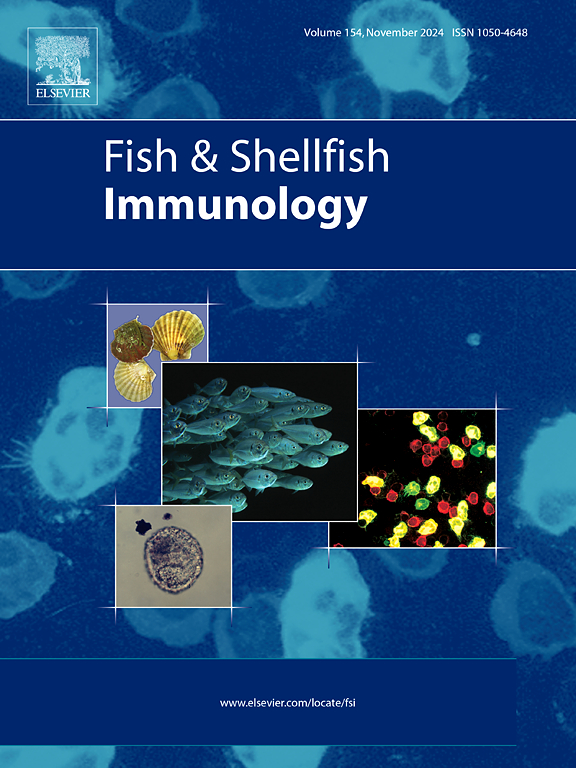Role of LuxS/AI-2 quorum sensing in Staphylococcus aureus biofilm formation, intestinal damage and pathogenesis in loach (Misgurnus anguillicaudatus)
IF 3.9
2区 农林科学
Q1 FISHERIES
引用次数: 0
Abstract
Staphylococcus aureus, a prevalent opportunistic pathogen, produces virulence factors that significantly threaten the health of aquatic animals and humans. The quorum sensing (QS) system is crucial for regulating virulence factor expression in pathogenic bacteria. However, the function by which QS regulates S. aureus intestinal colonization in aquatic animals and its subsequent adverse effects on the host have not been fully characterized. Here, we investigated the role of the LuxS/autoinducer-2 (AI-2) QS system in S. aureus strain SA, focusing on its impact on virulence factor expression, intestinal colonization, and host pathology. Using CRISPR-Cas9 technology, we successfully constructed the luxS gene deletion mutant strain SAΔluxS and its corresponding gene complementation strain SAΔluxS (luxS). Strain SAΔluxS exhibited impaired AI-2 synthesis but showed no significant changes in virulence factors such as enterotoxins, bacteriocins, and motility. However, its biofilm formation capacity was enhanced, primarily due to increased extracellular polysaccharide content within the biofilms. Exogenous addition of c-di-AMP led to enhanced biofilm formation in wild-type strain SA, and the elevated c-di-AMP levels in strain SAΔluxS were primarily attributed to reduced gdpP expression. Furthermore, LuxS/AI-2-mediated QS negatively regulated intestinal colonization of S. aureus and mitigated S. aureus-induced intestinal permeability, tissue disruption, and inflammatory response in loach (Misgurnus anguillicaudatus). These findings provide valuable insights into the mechanisms of S. aureus pathogenesis and contribute to developing novel strategies to prevent and control S. aureus infections in aquatic animals.

LuxS/AI-2群体感应在泥鳅金黄色葡萄球菌生物膜形成、肠道损伤及发病中的作用
金黄色葡萄球菌是一种普遍存在的机会致病菌,其产生的毒力因子严重威胁水生动物和人类的健康。群体感应(quorum sensing, QS)系统是调控致病菌毒力因子表达的关键系统。然而,QS调控金黄色葡萄球菌在水生动物肠道定植的功能及其对宿主的不良影响尚不完全清楚。在这里,我们研究了LuxS/autoinducer-2 (AI-2) QS系统在金黄色葡萄球菌SA中的作用,重点研究了它对毒力因子表达、肠道定植和宿主病理的影响。利用CRISPR-Cas9技术,我们成功构建luxS基因缺失突变株SAΔluxS及其对应的基因互补株SAΔluxS (luxS)。菌株SAΔluxS表现出AI-2合成受损,但在肠毒素、细菌素和动力等毒力因子方面没有明显变化。然而,其生物膜形成能力增强,主要是由于生物膜内细胞外多糖含量增加。外源添加c-di-AMP导致野生型菌株SA的生物膜形成增强,菌株SAΔluxS中c-di-AMP水平升高主要归因于gdpP表达降低。此外,LuxS/ ai -2介导的QS负向调节金黄色葡萄球菌的肠道定植,减轻金黄色葡萄球菌诱导的泥鳅(Misgurnus anguillicaudatus)肠道通透性、组织破坏和炎症反应。这些发现为了解金黄色葡萄球菌的发病机制提供了有价值的见解,并有助于制定新的策略来预防和控制金黄色葡萄球菌在水生动物中的感染。
本文章由计算机程序翻译,如有差异,请以英文原文为准。
求助全文
约1分钟内获得全文
求助全文
来源期刊

Fish & shellfish immunology
农林科学-海洋与淡水生物学
CiteScore
7.50
自引率
19.10%
发文量
750
审稿时长
68 days
期刊介绍:
Fish and Shellfish Immunology rapidly publishes high-quality, peer-refereed contributions in the expanding fields of fish and shellfish immunology. It presents studies on the basic mechanisms of both the specific and non-specific defense systems, the cells, tissues, and humoral factors involved, their dependence on environmental and intrinsic factors, response to pathogens, response to vaccination, and applied studies on the development of specific vaccines for use in the aquaculture industry.
 求助内容:
求助内容: 应助结果提醒方式:
应助结果提醒方式:


